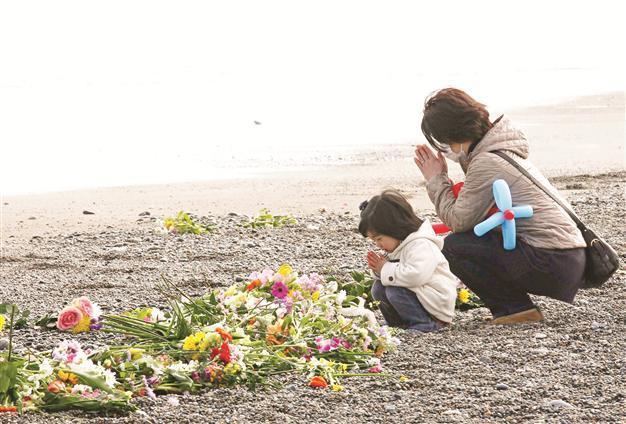Japan marks quake anniversary
RIKUZENTAKATA, Japan

People offer prayers for victims
of the March 11, 2011 earthquake
during the first anniversary of the
disaster in Iwaki. REUTERS photo
People across
Japan prayed and stood in silence yesterday to remember the massive earthquake and
tsunami that struck the nation one year ago, killing over 19,000 people and unleashing the world’s worst nuclear crisis in a quarter century.
In the devastated northeastern coastal town of Rikuzentakata, a siren sounded at 2:46 p.m., the exact time the magnitude-9.0 quake struck on March 11, 2011. At the same time in the seaside town of Onagawa, people facing the sea pressed their hands together in silent prayer.
At a memorial service in Tokyo’s National Theater, 78-year-old Emperor Akihito, Empress Michiko and Prime Minister Yoshihiko Noda stood in silence with hundreds of other people dressed in black, the Associated Press reported. Even in Tokyo’s busy shopping district of Shibuya, pedestrians briefly stopped and fell silent before carrying on. Noda said in a speech that the Japanese people had overcome disasters and difficulties many times in the past and pledged to rebuild the nation and the area around the tsunami-stricken Fukushima nuclear plant so that the country would be “reborn as an even better place.”
The earthquake was the strongest recorded in Japan’s history and set off a tsunami that swelled to more than 20 meters in some spots along the northeastern coast, destroying tens of thousands of homes and bringing widespread destruction. The tsunami also knocked out the vital cooling systems at the Fukushima Dai-ichi nuclear power plant, causing meltdowns at three reactors and spewing radiation into the air. Some 100,000 residents who were forced to flee remain in temporary housing or with relatives, and a 20-kilometer area around the plant is still off limits.
Reduce reliance on nuclear powerAll told, around 325,000 people rendered homeless or evacuated are still in temporary housing. While much of the debris along the tsunami-ravaged coast has been gathered into massive piles, very little rebuilding has begun. Beyond the massive cleanup, many towns are still finalizing reconstruction plans, some of which involve moving residential areas to higher and safer ground in ambitious and costly projects. Bureaucratic delays in coordination between the central government and local officials have also slowed rebuilding efforts.
The Japanese government has pledged to reduce reliance on nuclear power, which supplied about 30 percent of the nation’s energy needs before the disaster, but says it needs to restart some nuclear plants during the transition period.
Authorities say no one has died from radiation exposure since the disaster, but residents are worried the radiation might result in cancer in coming years. Scientists say there is no clear evidence of increased cancer risk from the estimated amount of radiation Fukushima residents have been exposed to although the health impact of low-dose radiation remains uncertain.
Noda has acknowledged failures in the government’s response to the disaster, including being too slow in relaying key information and believing too much in “a myth of safety” about nuclear power.
